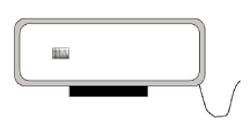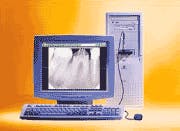Get ready to "Go Digital"
Dale A. Miles, DDS
How imaging can improve your bottom line.
"After 7-8 years, reading hundreds of journal articles, Web pages, and textbooks to educate myself about digital imaging and its impact on dental practices, I've arrived at the conclusion that the transition to a digital environment, although somewhat intimidating, is inevitable."
From: www.learndigital.net, October 2000
It's a digital world - for consumers and professionals. Your phone is digital, your fax is digital, and you've purchased a DVD player to watch "The Matrix." Why then have you not gone completely "digital" in your office? The answer is simple - you're habit-bound. With the exception of some "early adopters," our profession is very conservative. We expect that our patient-management software will last as long as our compressors. We practice dentistry the way we were taught in school. But technology's not like that. You must plan for "upgrades," both with equipment and software. There's no escape - it's time to embrace, rather than avoid, the inevitable.
How can radiology be profitable? In a recent survey, the combined median fee for the group of procedures including periodic oral exam (D0120), a four-film bitewing (D0274) and a panoramic X-ray (D0330) totaled $127.
If we subtract the average examination fee ($35) and the average panoramic fee ($65), it leaves $27 for 2 bitewing radiographs. Kodak has published film/processing costs of a single No. 2 film, including technical time (DAs time) at $1.11 per film. Each film then yields a profit of $12.39 on average. That's 11 times its cost, or a 116 percent profit. No wonder dentists don't want to change! Why should they "go digital"?
You're closer than you think
Most of us already own one or several computers. Those that do own computers likely use a patient-management program. If we're already doing "patient management" by computer, what's so hard about "image management" by computer? You have networked your computers to share information. They share the patient database that allows you to make appointments, track collections, and communicate with your patients. Once you add digital peripheral devices, these same computers must share more robust data, such as pictures, X-rays, and voice files.
Image acquisition is the same. You put a receptor in the mouth (a sensor - not film) and then expose it. The display is now on a computer monitor - a much larger version of the image you would have had using film. Now, you and the patient can see the information better. It's magnified automatically, and it's a repeatable quality each time. You're not looking at a 30 x 40 mm image on a view box on a shelf at some distance from the patient. You're looking at a better image, together! You can do "patient education" chair-side, like you do with your video camera image or digital still camera. The patient can see the cavity because it is 50-100 times the size of the image on film! This technology is a practice builder because it creates an educated consumer. And educated consumers will generate profit as well as pride and confidence.
The computer processes newly acquired images as binary data. This means that the information is coded with "0s" and "1s." These two numbers in various combinations allow the computer to recognize the data as a language, and also allow software instructions to tell it (the computer) how you wish to treat that data. That's all a digital image is - a set of numbers the computer recognizes and uses to perform the tasks that you command it to do. This is called EIP, or Electronic Image Processing. EIP is indisputably more dependable and less costly than chemical processing.
Electronic Image Processing
X-ray film, once processed, is a static display device. The only way to gain additional information from the image is through EIP. Yes, even X-ray film can be processed electronically if it is first scanned and stored in a digital format.
Of course, film digitization by scanning is more cumbersome. However, dentists may wish to do this for image comparison, improving image quality, or archiving the image content more durably. The digital image, whether scanned or directly acquired by a CCD or other solid-state detector, is displayed on a computer monitor for EIP. The image can be subjected to all kinds of processing steps or tools to extract more information to make better clinical decisions. Medical radiologists have used it for years.
Now, we can improve our interpretation of disease processes as well by selecting tools that enhance the features of the disease and make them more obvious. This is not image manipulation - it is EIP. It helps the dentist manage the patient's problem with more certainty.
Figure 1 shows how I enhanced the carious lesions in these periapical X-ray images to make them more visible. The technique to acquire the image is no different than with conventional X-ray techniques. The real challenge is to take the time to understand the elements necessary to make the transition: computers, networking, terminology, and electronic image processing (EIP). I hope the articles in this series will make your transition easier and more rewarding.
How can EIP increase my profit?
Digital X-ray imaging technology has several benefits that will enhance your bottom line, including:
- Increased auxiliary productivity
- Decreased annual overhead
- Improved diagnosis
- Patient treatment acceptance
- Productivity - Doctors who have switched to digital X-ray systems state that they are much more productive, especially with emergency and endodontic procedures. EIP eliminates the necessity of waiting for a critical image before proceeding with treatment. Waiting for an image before proceeding is intensely frustrating. It's even more frustrating if there is a "re-take!" Re-takes and delays strain our time-management resources beyond reason. With solid-state X-ray detectors, "re-takes" are instant.
If your diagnoses frequently depend upon the confirmational information in an X-ray image, digital imaging is for you. You will never read another "wet" film! Wet films not subjected to a second processing procedure to "fix" them properly will turn dark yellow and brown; for diagnostic purposes, they are as embarrassing as they are useless. EOP shortens the time required for those procedures that depend upon imaging for intratreatment evaluation. EOP also minimizes the technical time dental assistants need, freeing them for their chairside duties and thus improving productivity even more.
- Decreased annual overhead - In the January 1999 issue of the CDA Journal, Dr. Robert Langlais, Dr. Edwin Parks and I published an article, "Digital X-rays are here - Why aren't you using them?" that documents the savings practices can reap by adopting digital X-ray technology. In the example we used in this article, the initial cost savings, which were fixed asset costs, totaled about $3,700. This is about one-third of the cost of a digital X-ray system with one sensor. The ongoing cost savings were calculated at about $10,400 - about what you would pay for a premium system.
- Improved diagnosis - The costs for missed diagnoses - or "opportunity cost" can be substantial. Digital X-ray systems have been shown to be equal or better than conventional X-ray film in many published studies. An article by Drs. S.C. White and D.C. Yoon suggests that the reproducible image quality you get with digital images means that dentists are more likely to find more cavities with digital images. Most research supports the position that solid-state detector images perform as well as film-based images; that is, we need not worry about loss of diagnostic capability.
Digital technology can help dentists observe the early periapical changes of diseased pulp, as well as improve caries detection. This may reduce the need for additional routine vitality testing, again making them more productive and more certain of their diagnoses.
- Patient treatment acceptance - The use of a large X-ray image on a computer monitor is a powerful educational (and selling) tool. Patients now see those tiny black cavities on the distal surfaces of premolars on large monitors, instead of a tiny 30 x 40 mm conventional film on a view box! Patients have stopped saying things like, "Boy, doc, I can hardly see what you're looking at!" Patients now can observe the same disease information you do, such as cavities, periapical changes, and bone loss, which helps them make more informed treatment decisions. They'll appreciate the time spent educating them about their conditions and, just as with the video camera or digital still camera images, will be more accepting of the treatment proposal. Like it or not, patients are consumers, and they want to spend their money wisely.
Digital X-ray image technology can make a real impact on your practice. In future articles, I'll discuss digital panoramic imaging, digital still cameras, case presentations using digital images, as well as other digital imaging technologies and their ability to help you profit from their adoption. In the meantime, get ready to "Go Digital"!




